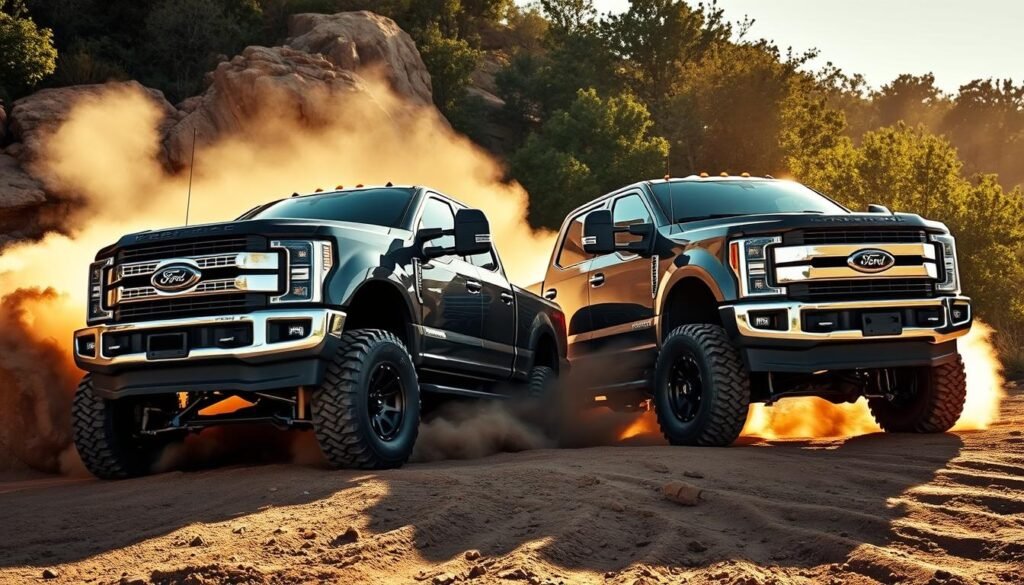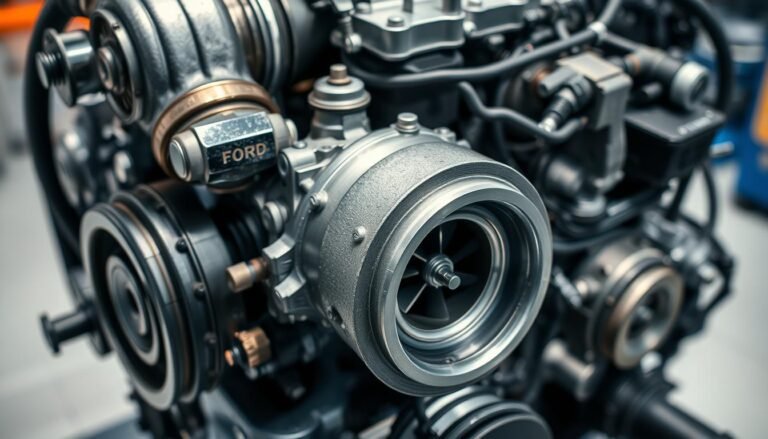Ford F250 vs F350: Which is Right For You?
Finding the perfect heavy-duty truck means knowing the differences between the Ford F250 vs F350. Both are known for their strength, flexibility, and work capability.
This guide will cover engine power, towing ability, and cost to help you choose the best one for you. The Ford F250 and F350 are built for tough tasks.
They have a lot in common, but important differences affect your drive and how you use the truck.
Depending on what you need, like towing a boat or moving big loads, it’s crucial to know these differences.
We’ll teach you about the unique features and specs of each truck. This will help you see what makes each one stand out in the heavy-duty truck world. Let’s look at what makes these two trucks different!
Introduction To Heavy-Duty Trucks
Heavy-duty trucks play a key role in many industries. They are important for towing and hauling big loads.
Trucks like the Ford F250 and F350 lead the market with their power and dependability. These trucks are used in a variety of settings.
Businesses use them for transport, and they’re also seen in agriculture and outdoor activities.
Their strong build and durability mean they last long and can handle tough tasks. Exploring the truck market shows many models for different needs.
Heavy-duty trucks stand out by making work easier and giving their owners confidence.
This introduction helps understand what makes these trucks unique, getting you ready to learn more about the Ford F-Series.
What is The Ford F-Series?
The Ford F-Series is a true American classic, loved by many across the nation. First introduced in 1948, it has evolved to meet various needs.
Today, it includes models like the F150, F250, and F350. Each is built for different tasks.
This truck line has grown impressively, adding new features and strength over the years. It’s known for its durable build and advanced tech.
The focus is on strong frames and powerful engines, making every F-Series model unique and reliable.
Ford ensures that truck buyers find just what they need by offering many engine choices and model configurations.
Whether you’re looking for a simple work truck or something to handle more demanding jobs, there’s an F-Series model for you.
Getting to know the history and design of the F-Series helps. It makes comparing models like the F250 and F350 much easier.
Ford F250 vs F350: A Comparison Overview
The Ford F250 and F350 are key players in the Ford F-Series. They are known for their strong performance and reliability.
When you compare them, you’ll notice important features and specs that help buyers choose. The F250 and F350 look similar, but they differ in size.
The F350 is wider because it offers a dual-rear-wheel option, which is great for towing. This might be important for you if carrying heavy loads is a priority.
The inside of these trucks also shows differences. The F350 has more room in the cabin, making it comfortable for passengers on long trips.
This is great if you need the truck for work and fun. In terms of price, the F250 is usually cheaper, but the F350’s features might make it worth the extra money.
Both models offer different configurations and trims to suit your needs. In the end, it’s important to look at each model’s specs before deciding.
Whether you like the F250’s lower price or the F350’s better capabilities, knowing what each offers is key.
Trim Levels and Customization Options
The Ford F250 and F350 are top choices in the heavy-duty truck market. They come with six trim levels: XL, XLT, Lariat, King Ranch, Platinum, and Limited.
You can pick one that suits your needs, whether it’s for tough work or luxury.

Available Trims For F250 and F350
Knowing the trims helps you choose wisely:
- XL: The base model focused on utility for work applications.
- XLT: Adds amenities for comfort without sacrificing capability.
- Lariat: Combines advanced features with a touch of luxury.
- King Ranch: Infused with western-themed aesthetics and high-end options.
- Platinum: Offers premium materials and advanced technology.
- Limited: The top-tier model loaded with exclusive features and finishing touches.
Distinct Features Across Trim Levels
Each trim has unique features for a better drive. You can customize your truck to fit your specific needs:
- Engine variants tailored to either performance or efficiency.
- Interior finishes that range from practical to extravagant.
- Wheel sizes and styles suited for various terrains.
- Different cab configurations to accommodate passengers or cargo.
This means you can make your Ford F250 or F350 truly your own. It will match your style and fulfill your needs perfectly.
Specifications and Engine Options
Learning about the Ford F250 and F350’s specs and engine choices can help you make smart decisions.
Both trucks come with a 6.8-liter gas V8 engine as standard, offering 405 horsepower and 445 lb-ft of torque.
If you need more strength, there’s a 7.3-liter gas V8 and two versions of the 6.7-liter Power Stroke turbo-diesel V8 engines. You can pick an engine that matches your needs perfectly.
Common Engine Choices
The selection of engines for the F250 and F350 is key to their performance. Here’s a quick overview of what’s available:
| Engine Type | Displacement | Horsepower | Torque |
|---|---|---|---|
| 6.8L Gas V8 | 6.8L | 405 hp | 445 lb-ft |
| 7.3L Gas V8 | 7.3L | 430 hp | 475 lb-ft |
| 6.7L Power Stroke Turbo-Diesel V8 (Standard) | 6.7L | 475 hp | 1,050 lb-ft |
| 6.7L Power Stroke Turbo-Diesel V8 (Optional High Output) | 6.7L | 500 hp | 1,200 lb-ft |
Performance Metrics
The engine’s power greatly impacts how much you can tow and carry. High horsepower and torque mean better performance with heavy loads.
Your choice of engine also affects speed and control. Understanding these details ensures your truck meets your specific needs.
Towing Capacity Comparison
When choosing between the Ford F250 and F350, towing capacity is crucial. Knowing their differences helps you pick wisely for your needs.
The towing abilities of these trucks differ, based on how you plan to tow.
Conventional Towing Techniques
The Ford F250 can tow up to 14,800 pounds with standard methods. This is enough for most trailers and RVs.
On the other hand, the F350 can tow up to 18,900 pounds. This makes it better for bigger loads.
Gooseneck Towing Capabilities
In gooseneck towing, which increases stability and efficiency, both trucks excel. The F250 handles up to 23,000 pounds.
But the F350 goes even further, with a capacity of 32,900 pounds. This shows the F350’s big advantage for heavy-duty towing.
Knowing the towing capacity differences between the Ford F250 and F350 aids in choosing the right truck.
This comparison not only shows their capabilities but also helps match your truck to your towing needs.
Payload Capacity Differences
The payload capacity of a truck is super important for different jobs. The Ford F250 and F350 have unique specs here.
The F250 can carry up to 4,268 pounds, great for heavy-duty stuff. But the F350 can handle up to 8,000 pounds, making it better for the really tough jobs.
How much a truck can carry changes how you use it. The F250 is good for lighter or medium loads.
But if you need to haul more, the F350 is the way to go with its better specs. Knowing the differences in payload capacity helps you choose the right truck.
Maybe you like the F250 for day-to-day use or the F350 for harder tasks. Compromise these points helps you get the most out of your truck.
Performance and Handling
The Ford F250 and F350 give you a great drive, focusing on how well they perform and handle. Both trucks do really well on the road.
Yet, the F350 often does better in tough spots thanks to its better suspension and stronger build.
Whether towing or carrying heavy stuff, these trucks offer stability and control that’s key for anyone who relies on their vehicle.
Driving Experience with F250 and F350
The F250 and F350 feel different to drive because of how they’re made. The F250 gives you a smooth ride and reacts well, making it great for daily use and some off-road fun.
The F350, however, has even better handling because of its solid design and better suspension, making it more stable when driving gets hard.
Off-road Capabilities
Both trucks do great off the road. Their ability to handle rough land shows they can deal with tough trails.
The F250 can handle light to moderate off-roading, while the F350 does even better.
It has better traction control and higher ground clearance, letting you take on different terrains with confidence that your truck can tackle tricky paths.

Fuel Efficiency Insights
When looking at heavy-duty trucks like the Ford F250 and F350, fuel efficiency is key. Knowing how weight impacts fuel use gives you useful info. This helps you choose the right model.
Learning Heavy-Duty Truck Fuel Economy
The EPA doesn’t offer official fuel economy figures for the Ford F250 and F350. These trucks have the same engines, but they differ in weight.
This affects how much fuel they use. The F250 weighs 6,340 pounds, while the F350 is heavier at 7,230 pounds.
Because of this, the F250 usually uses less fuel.
| Model | Curb Weight (lbs) | Estimated MPG (City) | Estimated MPG (Highway) |
|---|---|---|---|
| Ford F250 | 6,340 | 14 | 18 |
| Ford F350 | 7,230 | 12 | 16 |
The lighter F250 often has better fuel efficiency, saving you money. It’s crucial to think about how you drive when picking a model. This ensures you get the fuel economy you prefer.
Technology and Safety Features
The Ford F250 and F350 come loaded with the latest tech and important safety features. They’re perfect for those who value safety and staying connected.
Both trucks have various high-tech systems that boost your driving experience and keep you safe on the road.
Advanced Safety Systems in F250 and F350
The Ford F250 and F350 have many safety features to help you avoid accidents and handle different driving situations.
These include:
- Pre-Collision Assist: Helps detect potential collisions and can apply brakes automatically.
- Adaptive Cruise Control: Automatically adjusts speed to maintain a safe distance from vehicles ahead.
- 360-Degree Camera System: Provides a comprehensive view around the truck for easier maneuvering in tight spaces.
Infotainment Features Across Both Models
The F250 and F350 also have incredible tech for a great in-car experience. With the SYNC 4 infotainment system, you get:
- Enhanced Connectivity: Seamlessly integrates with smartphones for hands-free communication and navigation.
- Voice Recognition: Allows you to control functions safely without taking your hands off the wheel.
- Available Navigation: Offers turn-by-turn directions with real-time traffic updates to keep you informed during your travels.

Pricing Structure and Value For Money
It’s crucial to understand the Ford F250 and F350’s pricing before you choose. The F250 is more affordable because it can’t tow as much and has fewer options.
This makes it a great choice if you’re looking for good value without losing much performance.
Digging into both trucks, think about how different features and trims affect their value. The F350 costs more but has better capabilities for those who need them.
Comparing these models helps you decide which is best for you. Looking at what each trim offers helps you make the most of your money.
Ensure you pick a truck that meets your needs and fits your budget. Below, you’ll find a comparison of their prices:
| Model | Starting Price | Max Towing Capacity | Key Features |
|---|---|---|---|
| Ford F250 | $35,000 | 20,000 lbs | Base trim includes basic infotainment, safety features, and comfortable seating. |
| Ford F350 | $40,000 | 32,000 lbs | Enhanced infotainment, advanced safety technology, and premium interior options. |
Owner Testimonials and Reviews
Learning how the Ford F250 and F350 work in the real world can help you choose the right one.
Owner testimonials offer insights into what it’s like using these heavy-duty trucks every day. They help future buyers see which model fits their needs best.
Many owners talk about the importance of towing capacity. They share stories of the F350’s amazing power when pulling heavy loads.
Yet, some prefer the F250 for its mix of strength and gas mileage. People also talk about how easy it is to maintain both models.
They often say these trucks are reliable and last a long time, even in tough conditions.

| Owner Feedback | Model | Highlight |
|---|---|---|
| “Incredible towing capacity with the F350, handles every job with ease.” | F350 | Towing Power |
| The F250 is perfect for my needs, great fuel economy and reliability.” | F250 | Efficiency |
| “I love the comfort and layout of the F350’s cabin.” | F350 | Interior Comfort |
| “Maintenance has been straightforward on the F250. No issues so far!” | F250 | Maintenance |
Reading these owner testimonials and reviews offers a clear view of the Ford F250 and F350 in action.
These stories from users show the strong and weak points of each model. This helps buyers know what to expect and make a smart choice.
Conclusion
The comparison of the Ford F250 and F350 shows the strength of each heavy-duty truck. Both have great towing capacity and features.
This helps you make a good choice. Choosing between the F250 and F350 depends on price, payload, and use. The F350 is great for higher payload needs.
But, if you need something more affordable, the F250 is a practical choice. Knowing the differences between the F250 and F350 helps you make a smart choice.
This summary helps you pick the right truck for your needs. It will be a reliable choice for years.
FAQs
Q: What are the main differences between the Ford F250 and F350?
A: The F350 can handle more weight than the F250, both in towing and carrying loads. It tows up to 18,900 pounds, more than the F250’s 14,800 pounds. The F350 also holds more, with a maximum payload of 8,000 pounds, versus 4,268 for the F250.
Q: What engine options are available for the F250 and F350?
A: Both trucks start with a 6.8-liter gas V8 engine, which has 405 horsepower and 445 lb-ft of torque. They also offer a stronger 7.3-liter gas V8 and two kinds of 6.7-liter Power Stroke turbo-diesel V8 engines.
Q: How do the trims of the F250 and F350 differ?
A: Both have six levels of trims: XL, XLT, Lariat, King Ranch, Platinum, and Limited. Each trim level offers different features. The XL is basic, while the Limited is packed with luxury options.
Q: How does fuel efficiency compare between the F250 and F350?
A: The F250 is usually more fuel-efficient than the F350. This is because it’s lighter, weighing 6,340 pounds, compared to the F350’s 7,230 pounds.
Q: What safety features are available on the F250 and F350?
A: Both models are equipped with safety technologies. These include Pre-Collision Assist, Adaptive Cruise Control, and a 360-degree Camera System. These features help make the road and towing safer.
Q: What kind of towing capacities should I expect from the F250 and F350?
A: The F250 can tow up to 14,800 pounds conventionally, while the F350 can tow up to 18,900 pounds. For gooseneck towing, the numbers increase. The F250 can tow up to 23,000 pounds, and the F350 can manage up to 32,900 pounds.
Q: How do owner testimonials reflect the performance of these trucks?
A: Owners often praise both trucks for their performance, durability, and comfort. Many point out the F350’s powerful towing capacity. Others suggest the F250 is more suited for daily tasks due to its economy.







